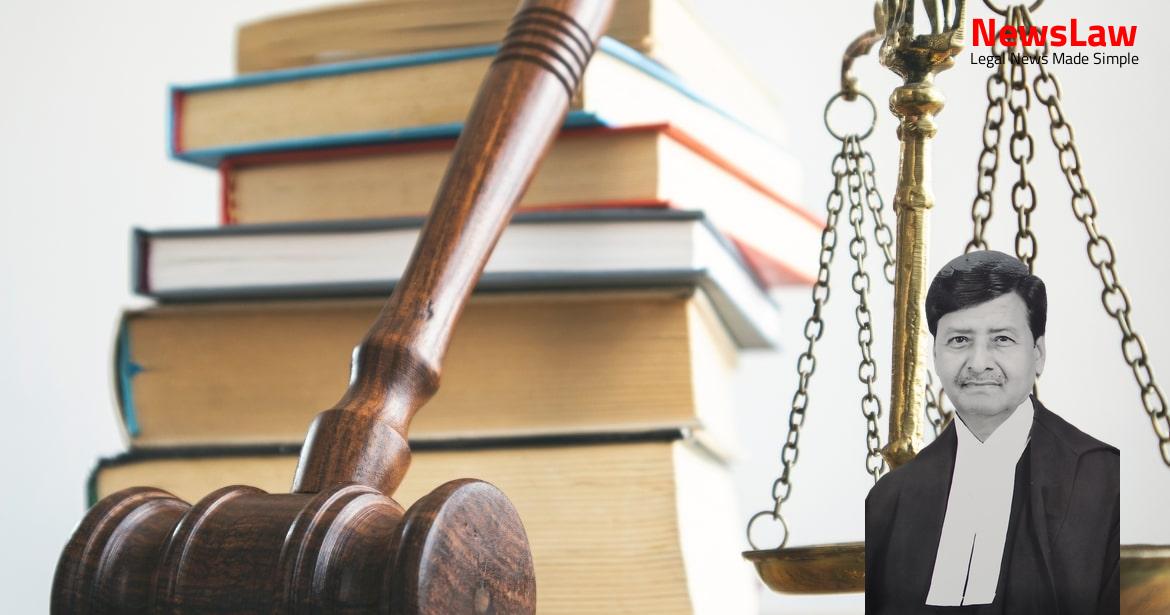In a recent murder case, the courts delved into the intricacies of analyzing circumstantial evidence to determine the accused’s guilt. The case highlights the critical role of a complete chain of evidence in reaching a verdict. Join us as we unravel the legal analysis of this intriguing case.
Facts
- The Trial Court convicted the accused for the murder of Kavita Sahu and Gaurang Sahu under Section 302 IPC.
- Accused sentenced to life imprisonment and a fine of Rs. 25,000.
- Accused appealed to the High Court and was acquitted due to lack of complete chain of circumstances in the prosecution’s evidence.
- High Court noted that there was no direct evidence linking the accused to the crime.
- Mother of the victims and the State have filed appeals against the High Court’s acquittal of the accused.
- Plea of the accused was recorded.
- Investigating Officer collected incriminating material from the spot.
- Search was launched for the accused Rahul.
- Search for the accused was based on the statement of Sidharth Vashisht.
- Accused bought the knife used in the offence according to a shopkeeper’s statement.
- Investigation involved various witnesses including Dr. Davinder Kapil and Inspector Amanjot Singh.
- Accused denied the charges during the investigation.
- Post-mortem examinations were conducted at General Hospital, Sector-16, Chandigarh.
- Sealed parcels were sent to CFSL, Sector 36, Chandigarh for testing.
- Charge sheet filed against the accused under Section 302 IPC.
- Investigation findings included recovery of blood-stained clothes and a sweater.
- Statements of witnesses recorded under Section 161 Cr.P.C.
- Case transferred to Crime Branch (SIT), Chandigarh for further investigation.
Also Read: Challenging Legal Presumptions in Negotiable Instrument Cases
Arguments
- The Shopkeeper (PW-9) identified the knife purchased by the accused and recovered from the place of occurrence
- The Loi recovered at the instance of the accused had blood stains matching the accused’s blood group
- The accused sustained an injury on his ring finger after the incident, proven by Dr. Davinder Kapil, PW-20
- Accused failed to explain the incriminating material against him – blood-stained Loi and knife
- Motive established through witness statements despite one witness turning hostile
- Prosecution successfully proved the motive of the accused to kill the deceased
- The defense counsel vehemently opposes the appeals on behalf of the respondent-accused.
- The High Court found that the prosecution failed to prove the link evidence necessary to establish the guilt of the accused.
- The case is based on circumstantial evidence, and a key witness, PW-8, turned hostile.
- The ownership of the blood-stained Loi attributed to the accused was not proven.
- The prosecution also failed to establish a motive conclusively.
- An old injury was cited as explanation for an injury on the accused’s finger.
- Given the lack of direct evidence and reliance on circumstantial evidence, the High Court’s acquittal of the accused was reasoned and should not be interfered with.
Also Read: Legal Analysis of Admission Irregularities in Educational Institutions
Analysis
- The knife used in the offense was found broken into three pieces with bloodstains, indicating it may have broken during the crime.
- Gaurang had thirteen injuries and Kavita had eight injuries, establishing the violent nature of the crime.
- Witness testimony revealed that the accused had a ring finger injury, misleadingly stating it was from an iron bar.
- Accused’s behavior and gestures towards the deceased prior to the incident were suggestive of a motive.
- Post-mortem and medical reports confirmed the cause of death to be hemorrhage and shock from a slit throat.
- Evidence of weapon used during the crime was supported by a member of the post-mortem board.
- Recovery of a knife in three pieces, purchased by the accused, linked him directly to the crime scene.
- Accused failed to explain his injury, further incriminating him.
- Prosecution successfully established the motive and the use of the weapon through witness testimonies and physical evidence.
- CFSL report and witness depositions confirmed blood on the weapon matched that of the deceased and the accused.
- The High Court did not properly consider all the evidence on record
- The Trial Court’s findings were based on a thorough examination of the evidence
- The High Court’s decision to reverse the conviction and acquit the accused is not supported
- The judgment and order of the High Court should be quashed and set aside
Also Read: Legal Analysis: Driver Appointment Dispute
Decision
- The High Court’s judgment acquitting the accused has been quashed and set aside.
- The Trial Court’s judgment of convicting the accused under Section 302 IPC has been restored.
- The accused must surrender to the Jail Authority/Court to undergo the sentence.
- The present appeals are allowed, and pending applications are disposed of accordingly.
- The present appeals succeeded due to the stated reasons.
Case Title: MALTI SAHU Vs. RAHUL (2022 INSC 702)
Case Number: Crl.A. No.-000471-000471 / 2022



